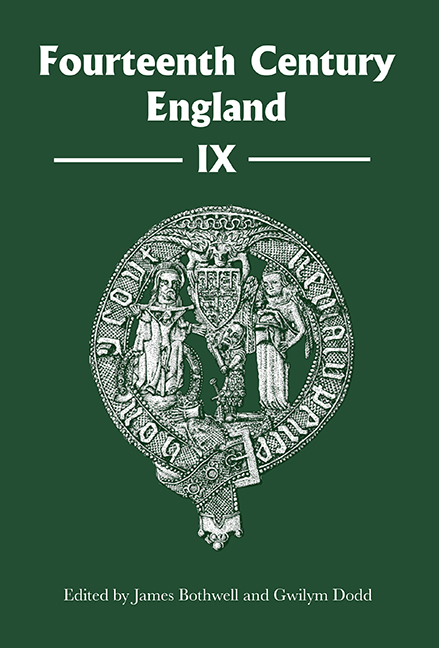Book contents
- Frontmatter
- Contents
- List of Illustrations
- Contributors
- Preface
- Abbreviations
- The Death of Edward II Revisited
- Living in the Shadows: John of Eltham, Earl of Cornwall (1316–36)
- Careers of the Lesser Parochial Clergy Before the Black Death
- Heritage and Symbolism: the Romans and Tanners in Fourteenth-Century York
- ‘Let Them Realize What God Can Do’: Chivalry in the St Albans Chronicle
- Historical Writing in the North-West Midlands and the Chester Annals of 1385–88
- High-Status Execution in Fourteenth-Century Ireland
- Traitor to the Chose Publique: Negotiating Constitutional Conflict Through the Law of Treason 1399–1402
- Notes and Documents – A Letter from Chatton: the Date and the Writer
- Fourteenth Century England Issn 1471–3020
The Death of Edward II Revisited
Published online by Cambridge University Press: 07 May 2022
- Frontmatter
- Contents
- List of Illustrations
- Contributors
- Preface
- Abbreviations
- The Death of Edward II Revisited
- Living in the Shadows: John of Eltham, Earl of Cornwall (1316–36)
- Careers of the Lesser Parochial Clergy Before the Black Death
- Heritage and Symbolism: the Romans and Tanners in Fourteenth-Century York
- ‘Let Them Realize What God Can Do’: Chivalry in the St Albans Chronicle
- Historical Writing in the North-West Midlands and the Chester Annals of 1385–88
- High-Status Execution in Fourteenth-Century Ireland
- Traitor to the Chose Publique: Negotiating Constitutional Conflict Through the Law of Treason 1399–1402
- Notes and Documents – A Letter from Chatton: the Date and the Writer
- Fourteenth Century England Issn 1471–3020
Summary
In September 1327, the death was announced of Edward of Caernarfon, formerly king of England, at Berkeley Castle, Gloucestershire. On 19 March 1330, Edmund, earl of Kent, the king's uncle, was executed for the crime of plotting to rescue Edward, in the belief that he was still alive and a prisoner in Corfe Castle in Dorset. Thereafter, speculation about Edward's possible survival was – perhaps understandably – muted. And so it remained for the next five centuries. Then, in 1877, Alexandre Germain, dean of the Faculty of Letters at Montpellier, published a transcript of an extraordinary letter, purporting to record Edward's own account of how he escaped from Berkeley and, after spending time in Corfe Castle, Ireland, France and Germany, ended up as a hermit in Italy. Since then, the possibility of Edward's survival after 1327 has been the subject of some historical debate – albeit a debate that has aptly been described as ‘extraordinarily slow-moving’.
The most forthright case for Edward's survival has been made by the historian Ian Mortimer. He argues that the announcement of Edward's death was a fabrication; that the corpse buried at Gloucester was not Edward’s; and that Edward III was subsequently informed that his father was not dead. This whole charade was arranged by Sir Roger Mortimer, who had led the coup against Edward II and was effectively in charge of Edward III's government. It was intended to forestall plots to reinstate Edward II as king, while simultaneously strengthening Roger's hold over the young Edward III, through the threat that he might be displaced by his still living father. Ian Mortimer concludes by claiming that, in the light of his arguments, ‘we cannot say that Edward II “almost certainly” died in Berkeley Castle, rather that the reverse is true: it is almost certain that he did not’.
Mortimer's thesis has commanded somewhat less than universal acceptance;4 in response, he has mounted a vigorous defence in a collection of essays, in which he has expanded and developed his argument. Claiming that his work will one day become the historical orthodoxy, he argues that his critics have not properly engaged with his methodology.
- Type
- Chapter
- Information
- Fourteenth Century England IX , pp. 1 - 22Publisher: Boydell & BrewerPrint publication year: 2016

